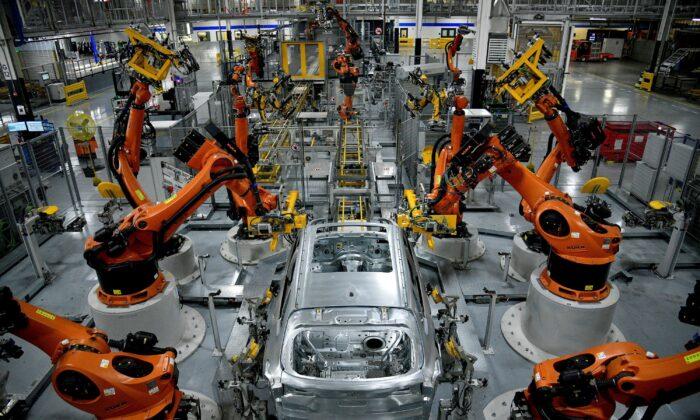WASHINGTON—U.S. manufacturing activity slowed in October, with all industries reporting record-long lead times for raw materials, indicating that stretched supply chains continued to constrain economic activity early in the fourth quarter.
The Institute for Supply Management (ISM) survey on Monday also hinted at some moderation in demand amid surging prices, with a measure of new orders dropping to a 16-month low. Still, demand remains strong amid depressed retail inventories, which should keep manufacturing humming.
According to the ISM, “companies and suppliers continue to deal with an unprecedented number of hurdles to meet increasing demand.” The government reported last week that the economy grew at its slowest pace in more than a year in the third quarter because of widespread shortages tied to the COVID-19 pandemic.
“Stress in U.S. supply chains isn’t abating, lending downside risk to our forecast for GDP growth in the near term and a clear upside risk to the forecast for inflation,” said Ryan Sweet, a senior economist at Moody’s Analytics in West Chester, Pennsylvania.
The ISM’s index of national factory activity slipped to a reading of 60.8 last month from 61.1 in September. A reading above 50 indicates expansion in manufacturing, which accounts for 12 percent of the U.S. economy. Economists polled by Reuters had forecast the index would fall to 60.5.
The ISM reported 26 commodities in short supply in October.
The economy is struggling with shortages across industries as global supply chains remain clogged. Supply constraints were worsened by a wave of coronavirus infections driven by the Delta variant over the summer, especially in Southeast Asia. Congestion at ports in China and the United States were also causing delays in getting materials to factories and retailers.

The motor vehicle industry has been the hardest hit. Transportation equipment manufacturers in the ISM survey reported they had diverted chips “to our higher-margin vehicles and stopped or limited the lower-margin vehicle production schedules.”
Other industries are also hurting. According to the ISM survey, manufacturers of computer and electronic products reported “extreme delays” and that “getting anything from China is near impossible.” Food manufacturers said “rolling blackouts in China starting to hurt shipments even more.”
Makers of electrical equipment, appliances, and components said though demand continued to be strong, production continued “to be held back by supply chain issues.”
The ISM survey’s measure of supplier deliveries increased to a reading of 75.6 last month from 73.4 in September. A reading above 50 percent indicates slower deliveries. Economists and businesses expect supply chains could remain tight through 2022.
Longer waits for materials meant high inflation at the factory gate persisted. The survey’s measure of prices paid by manufacturers accelerated to 85.7 from a reading of 81.2 in September. Prices increased for 48 commodities last month, with only prices for wood falling.
These higher costs are being passed on to consumers which, together with surging wage growth, is raising concerns that high inflation could be more persistent rather than transitory as Federal Reserve Chair Jerome Powell has repeatedly argued. The government reported on Friday that wage growth in the third quarter was the strongest on record.
The ISM survey’s forward-looking new orders sub-index dropped to 59.8 last month, the lowest reading since June 2020, from 66.7 in September. With customer inventories remaining depressed, a rebound is likely.
Fourteen out of 18 industries reported growth in new orders, including furniture and related products, primary metals and machinery, as well as computer and electronic products manufacturers. Only the nonmetallic mineral products and plastics and rubber products industries reported a decline in orders.

Glimmers of Hope
Subsiding coronavirus cases could, however, encourage more consumption of services and curb demand for goods. Though a measure of unfinished work dipped last month, order backlogs remain significantly high.Factories hired more workers, with a measure of employment increasing to a reading of 52 from 50.2 in September. Employment rose in the computer and electronic products, fabricated metal products, and chemical products industries.
Though manufacturers companies said they were still struggling to find workers, there were signs of improvement.
According to the ISM, “an increasing percentage of comments noted improvements regarding employment, compared to less than 5% in September.” It also noted that “an overwhelming majority of panelists indicate their companies are hiring or attempting to hire.”
This, combined with a massive improvement in consumers’ perceptions of the labor market last month, suggest employment gains picked up in October after the economy created the fewest jobs in nine months in September.
Worker shortages, however, remain a constraint. There were 10.4 million unfilled jobs at the end of August. The Labor Department is scheduled to publish its closely watched employment report for October on Friday.
A separate report from the Commerce Department on Monday showed construction spending dropped 0.5 percent in September amid broad declines in outlays on both private and public projects, which were partly blamed on Hurricane Ida in late August. Construction spending edged up 0.1 percent in August.
Still, the composition of construction spending was not as weak as the government had assumed in its advance third-quarter GDP estimate last week. That led some economists to anticipate that third-quarter GDP growth could be revised higher to about a 2.2 percent rate from the published 2.0 percent pace when the government releases its second estimate later this month.





